
- 352 pages
- English
- ePUB (mobile friendly)
- Available on iOS & Android
Basic Anatomy and Physiology for the Music Therapist
About This Book
Providing need-to-know information about the human body for music therapists, this book covers the elements of anatomy and physiology that are of particular relevance to clinical practice.
Addressing both the structure and function of the human body, the material is presented with the music therapist in mind. Particular attention is paid to the role of music in affecting responses from the organ systems, including the senses, the endocrine glands, the immune system, the musculo-skeletal system, the nervous systems and the vestibular system. Dr Schneck also uses accessible musical metaphors to explain complex biological information.
Emphasising the symbiotic relationship between music and the body, this book reveals how an understanding of this relationship can help music therapists to practice more effectively, and will be of interest to students and practitioners alike.
Frequently asked questions
Information
THIS THING
CALLED “ME”?
Table 1.1 “Average” elemental composition of the “typical” human adult | |||
ELEMENT | % OF BODY WEIGHT | ELEMENT | % OF BODY WEIGHT |
Oxygen | 63.000 | Antimony | Trace |
Carbon | 20.700 | Arsenic | Trace |
Hydrogen | 10.000 | Barium | Trace |
Nitrogen | 2.800 | Berylium | Trace |
Calcium | 1.575 | Boron | Trace |
Phosphorus | 1.050 | Cesium | Trace |
SUB-TOTAL | 99.125 | ||
Potassium | 0.247 | Chromium | Trace |
Sulfur | 0.207 | Cobalt | Trace |
Chlorine | 0.137 | Gold | Trace |
Sodium | 0.131 | Iodine | Trace |
Magnesium | 0.034 | Lithium | Trace |
Silicon | 0.026 | Manganese | Trace |
SUB-TOTAL | 99.907 | ||
Iron | 0.0050 | Mercury | Trace |
Fluorine | 0.0037 | Molybdenum | Trace |
Zinc | 0.0033 | Nickel | Trace |
Rubidium | 0.0005 | Radium | Trace |
Strontium | 0.0005 | Selenium | Trace |
Bromine | 0.0003 | Silver | Trace |
Lead | 0.0002 | Tin | Trace |
Copper | 0.0001 | Tungsten | Trace |
Aluminum | 0.0001 | Uranium | Trace |
Cadmium | 0.0001 | Vanadium | Trace |
SUB-TOTAL | 99.9208 | TOTAL | 100.0% |
Table of contents
- Cover
- Half Title
- By The Same Author
- Title Page
- Copyright
- Dedication
- Contents
- Preface
- Introduction: The Symbiotic Relationship Between Music and the Human Body
- PART 1 WHAT IS THIS THING CALLED “ME”?
- PART II HOW DOES “ME” WORK?
- References
- Subject Index
- Author Index